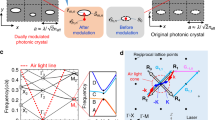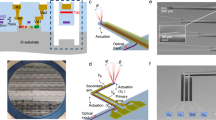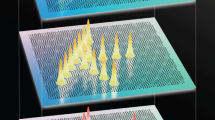Abstract
Compact lasers that can produce a range of beam patterns are important for progress in several areas, including the improvement of optical tweezers1, ultra-high-density optical memory2 and microfluidics3. Here we engineer photonic crystals to generate semiconductor lasers that produce a range of beam patterns while maintaining stable single-mode oscillation. Our results could contribute to the realization of compact lasers that are capable of producing diverse beam patterns on demand.
Similar content being viewed by others
Main
The beam (far-field) pattern emitted by a semiconductor laser is determined by the Fourier transformation of the electromagnetic field distribution in its output plane. It is therefore important to find a method of controlling the electromagnetic field while maintaining stable single-mode oscillation. An array of vertical-cavity surface-emitting lasers has been investigated4, but without achieving stable and flexible control of the field distribution. The use of a band-edge effect in two-dimensional photonic crystals5,6,7,8, in which the refractive index is changed periodically, is a promising way to get this control. The group velocity of light becomes zero at the band edge, which gives rise to the formation of a large and stable two-dimensional single-cavity mode, and the output beam is emitted in the direction normal to the crystal plane, using the crystal itself as a diffraction grating.
We therefore developed photonic-crystal lasers based on the band-edge effect by engineering lattice points7 and/or lattice phases9,10 in the crystal structure in order to control the internal field distribution (see supplementary information). Scanning electron micrographs of the fabricated photonic crystals are shown in Fig. 1 (a–f, left panels). The engineered photonic-crystal lasers all display stable single-mode oscillation at room temperature; the maximum output power exceeds 45 mW under continuous-wave conditions.
a–f, Scanning electron micrographs of crystal structures (left panels) and observed beam patterns (right panels) for circular lattice points with no lattice shifts, with one shift, with parallel double shifts, with crossed shifts and with double-crossed shifts, and for triangular lattice points with no shifts, respectively. Details, including those of the device structure and of beam-pattern control, are explained in supplementary information.
The surface-emitted beams had a variety of shapes, including single, twin and quadruplet doughnuts, either separated or touching, and circular single-lobed forms (Fig.1, right panels). Divergence angles of these beams were less than 2°, reflecting the large area (about 50×50 µm2) of coherent oscillation. An even larger area of coherent oscillation can be achieved by adjusting the distance between the photonic crystal and the active layer in the device's structure (see supplementary information).
The mechanisms by which the individual beam types are produced can be explained qualitatively. The beam patterns reflect the field distribution within one unit cell of the crystal lattice. Circular lattice points give rise to a rotationally symmetrical field distribution (see supplementary information). Interference in the far field produces a doughnut-shaped beam (Fig. 1a), which can have either tangential or radial polarization (see supplementary information). Shifts of the crystal lattice by half of the lattice constant produce phase shifts in the field distributions: the resultant far-field interactions are reversed, leading to the formation of various types of doughnut beam (Fig. 1b–e, and see supplementary information).
When the structure of the lattice points is modified, the field distribution within one unit cell is altered: for example, with triangular lattice points, destructive interference in the far field does not occur in the x-direction, which reflects the asymmetry around the lattice point in this direction; as a result, a circular single-lobed beam can be obtained (Fig.1f, and see supplementary information).
Further engineering of the photonic crystal structures described here should allow novel beams to be generated. This will define a new direction for semiconductor lasers and could lead to the realization of compact lasers with on-demand beam characteristics.
References
Ashkin, A. IEEE J. Sel. Top. Quant. Electron. 6, 841–856 (2000).
Dorn, R., Quabis, S. & Leuchs, G. Phys. Rev. Lett. 91, 233901 (2003).
MacDonald, M. P., Spalding, G. C. & Dholakia, K. Nature 426, 421–424 (2003).
Raftery, J. J. Jr, Danner, A. J., Lee, J. C. & Choquette, K. D. Appl. Phys. Lett. 86, 201104 (2005).
Imada, M. et al. Appl. Phys. Lett. 75, 316–318 (1999).
Meier, M. et al. Appl. Phys. Lett. 74, 7–9 (1999).
Noda, S., Yokoyama, M., Imada, M., Chutinan, A. & Mochizuki, M. Science 293, 1123–1125 (2001).
Letartre, X., Monat, C., Seassal, C. & Viktorovitch, P. J. Opt. Soc. Am. B 22, 2581–2595 (2005).
Witjaksono, G. & Botez, D. Appl. Phys. Lett. 78, 4088–4090 (2001).
Miyai, E. & Noda, S. Appl. Phys. Lett. 86, 111113 (2005).
Author information
Authors and Affiliations
Corresponding author
Ethics declarations
Competing interests
The authors declare no competing financial interests.
Supplementary information
Rights and permissions
About this article
Cite this article
Miyai, E., Sakai, K., Okano, T. et al. Lasers producing tailored beams. Nature 441, 946 (2006). https://doi.org/10.1038/441946a
Received:
Accepted:
Published:
Issue Date:
DOI: https://doi.org/10.1038/441946a
This article is cited by
-
Design of low-threshold photonic-crystal surface-emitting lasers with confined gain regions by using selective area intermixing
Discover Nano (2023)
-
Exceptional points and non-Hermitian photonics at the nanoscale
Nature Nanotechnology (2023)
-
Topological-cavity surface-emitting laser
Nature Photonics (2022)
-
Wide-bandgap GaN-based watt-class photonic-crystal lasers
Communications Materials (2022)
-
Vertically integrated diffractive gratings on photonic crystal surface emitting lasers
Scientific Reports (2021)
Comments
By submitting a comment you agree to abide by our Terms and Community Guidelines. If you find something abusive or that does not comply with our terms or guidelines please flag it as inappropriate.




